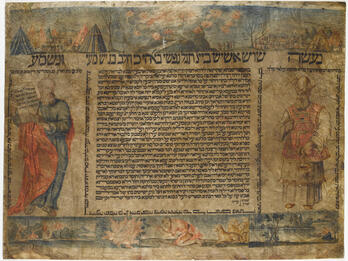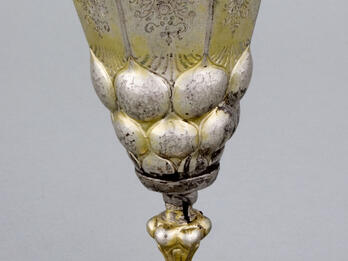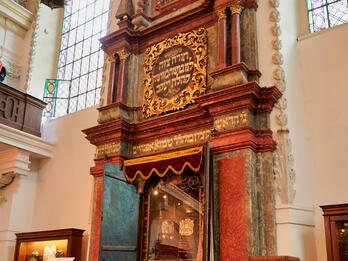Ketubah between God and Israel for Shavuot
Artist Unknown
17th–18th Century
In the Sephardic tradition, a “marriage contract” (ketubah), a symbolic betrothal of God and Israel, is read before the Torah reading on the first day of the holiday of Shavuot, which celebrates the giving of the Torah to the people of Israel. This rare example of such a ketubah is from Italy. The figures of Moses and Aaron stand to either side of the text, and other stories from the life of Moses are illustrated above and below it.
Credits
Marriage Contract for Shavuot. Gift of Dr. Harry G. Friedman / The Jewish Museum, New York.
Published in: The Posen Library of Jewish Culture and Civilization, vol. 5.
You may also like

Ketubah for Shavuot
In the Sephardic tradition, a “marriage contract” (ketubah), a symbolic betrothal of God and Israel, is read before the Torah reading on the first day of the holiday of Shavuot.
Her bitter soul is anguished: For Tishah be-Av
Her bitter soul is anguished, because of her ailing wound.
The city one teeming with people is desolate, the Holy City that she had inherited.
For the glorious, sweet land, tears descend like a…

Kiddush Cup (Nuremberg)
Kiddush cups are used for the ritual blessing over wine. This one, partially made of gold, was crafted in Nuremberg, Germany, and was used in a synagogue in Lublin, Poland. The engraved plant and…
Yosef omets (He Will Be Stronger): On the Ten Days of Repentance
980. It is written in Re’shit ḥokhmah [The Beginning of Wisdom (1579), by Elijah de Vidas]: The name of the Ten Days of Repentance indicates that they were ordained to amend the year. They are days of…

Torah Ark in the Klausen Synagogue
The Klausen Synagogue in Prague gets its name from the kloyz (a complex of buildings used for religious purposes, including synagogues) that originally stood on its site, erected in the 1570s. The…
Yosef omets (He Will Be Stronger): On Yom Kippur Eve
985. The ancient custom of kaparot [having a chicken slaughtered after symbolically transferring one’s sins to it] is well known; I will only write that my custom is also to say, based on the Maharal…
Engage with this Source
Related Guide
Early Modern Rabbis and Intellectuals on the Move
1500–1750
Carrying books and knowledge, itinerant rabbis and scholars traveled between communities, facilitating cultural exchange.
Related Guide
Early Modern Italy: Where East and West Meet
1500–1750
Ashkenazim, Sephardim, and Marranos encountered each other in Italian cities, developing community structures that later influenced Jewish communal organization throughout the western world.
Related Guide
Early Modern Religious Practices
1500–1750
Early modern Jews both preserved tradition and innovated. Documents and legal texts reveal rich details about synagogue life, marriage, family relations, and death rituals.
You may also like

Ketubah for Shavuot
In the Sephardic tradition, a “marriage contract” (ketubah), a symbolic betrothal of God and Israel, is read before the Torah reading on the first day of the holiday of Shavuot.
Her bitter soul is anguished: For Tishah be-Av
Her bitter soul is anguished, because of her ailing wound.
The city one teeming with people is desolate, the Holy City that she had inherited.
For the glorious, sweet land, tears descend like a…

Kiddush Cup (Nuremberg)
Kiddush cups are used for the ritual blessing over wine. This one, partially made of gold, was crafted in Nuremberg, Germany, and was used in a synagogue in Lublin, Poland. The engraved plant and…
Yosef omets (He Will Be Stronger): On the Ten Days of Repentance
980. It is written in Re’shit ḥokhmah [The Beginning of Wisdom (1579), by Elijah de Vidas]: The name of the Ten Days of Repentance indicates that they were ordained to amend the year. They are days of…

Torah Ark in the Klausen Synagogue
The Klausen Synagogue in Prague gets its name from the kloyz (a complex of buildings used for religious purposes, including synagogues) that originally stood on its site, erected in the 1570s. The…
Yosef omets (He Will Be Stronger): On Yom Kippur Eve
985. The ancient custom of kaparot [having a chicken slaughtered after symbolically transferring one’s sins to it] is well known; I will only write that my custom is also to say, based on the Maharal…



